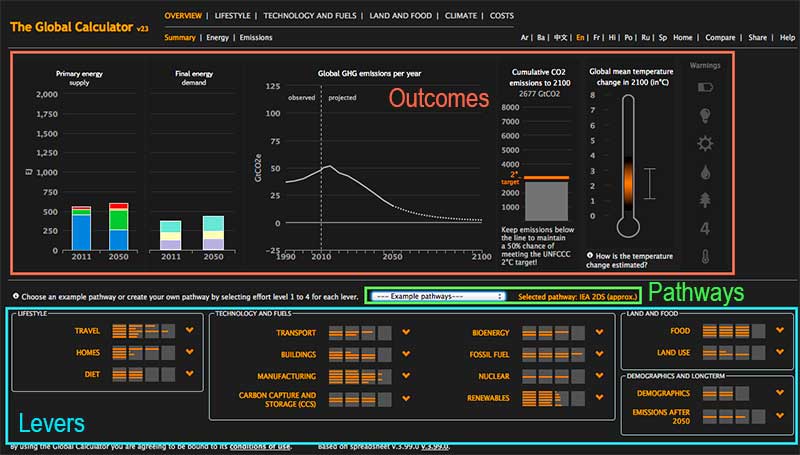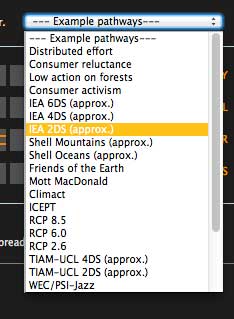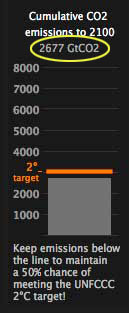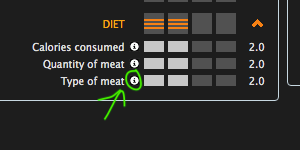The Global Calculator
The Global Calculator site describes it as "an open-source model of the world's energy, land and food system...that allows you to design your own vision of the future and see the implications for the climate instantly".
You choose how aggressively you think we should pursue certain climate-related of policies by setting "levers" from...
- 1 means "Business as usual"--little or no attempt to change current trends
- 2 and 3 are increasingly aggressive policies, but imply targets which governments have already committed to, or changes policy experts think are feasible.
- 4 is a kind of dramatic change that would typically require a large investment of political capital!
Based on your choices, the tool will calculate the total amount of $CO_2$ in the atmosphere by 2100 and the anticipated temperature rise.
But who's behind it? Is it a government agency? A university? A multinational corporation? (I'll ask you below to address this...)
Using the calculator
The calculator itself is at tool.globalcalculator.org.

There are three main regions of the screen. Starting from the bottom:
Levers or assumptions. You can click on one of the four boxes in each category to set the effort level from 1=minimal abatement (left box) to 4=extremely ambitious (right box). The orange horizontal lines indicate that these are categories with sub-items. If you click the down arrow you can see and manipulate the individual sub-items. But for this assignment, We're just interested in the overall impact of changes by category.
 Pathways A "pathway" is a particular set of assumption. Instead of you starting from scratch with all the lever settings, a few organizations have proposed policies, and then translated those policies into particular settings of the levers. Drop down the menu to select one.
Pathways A "pathway" is a particular set of assumption. Instead of you starting from scratch with all the lever settings, a few organizations have proposed policies, and then translated those policies into particular settings of the levers. Drop down the menu to select one.
 Outcomes Several graphs showing climate and related outcomes of the lever settings chosen
are shown in this part of the screen. For this assignment, We're most interested in the "Cumulative CO2 emissions to 2100", which also shows how the emissions compare with the estimated carbon that would lead to 2C of warming by 2100.
Outcomes Several graphs showing climate and related outcomes of the lever settings chosen
are shown in this part of the screen. For this assignment, We're most interested in the "Cumulative CO2 emissions to 2100", which also shows how the emissions compare with the estimated carbon that would lead to 2C of warming by 2100.
Which category has the largest effect on emissions?
By category, I mean the 15 items in orange, Travel, Homes, Diet, Transport, Buildings, etc. Not the 4 groups of categories.
- Start by selecting the IEA 2DS pathway.
 Now move the lever for a particular category to level 1. That is, click on the left-most box of a particular category. Note how many GtCO2 are calculated.
Now move the lever for a particular category to level 1. That is, click on the left-most box of a particular category. Note how many GtCO2 are calculated.
 Now move the lever to level 4 (click on the right-most box) for that category and note how many GtCO2 are calculated.
Now move the lever to level 4 (click on the right-most box) for that category and note how many GtCO2 are calculated.
- Jot down for yourself the difference between these two numbers (the total change in CO2 emissions).
Do this in turn for each category.
Each time you switch categories, you should first select the IEA 2DS pathway again to reset all the levers to the same starting values.
- Proceeding as above, to look at the *change* in emissions when you move the category "lever" from 1 to 4 in each category. Eventually you'll write down in order the 15 categories from largest effect on Carbon in the atmosphere to least, together with the difference that each category makes.
- Which of the 15 categories has the biggest effect on climate emissions?
- Drop down the menu on this category, and read the information page (click the 'i') on one of the sub-items. Read a bit to find out why changes to this sub-item have an effect on carbon (CO2) emissions. In a few sentences, why do changes to this sub-item have an effect on carbon (CO2) emissions?
- Which category has the next-largest effect?
- Poke around the global calculator website [This is the Internet Archive cache of globalcalculator.org] to answer the question: Where is the funding coming from for this project?
- [Each person in the group do this. But include your writing in your group report.]
Choose one of the items that interests you. Read the information about that policy.
 For example (see right) if you want to read more about the diet choices, drop down the diet item, and choose one of the topics to read up on. If I wanted to read more about the type of meat, I'd click on the little "i" (for information) next to that choice.
For example (see right) if you want to read more about the diet choices, drop down the diet item, and choose one of the topics to read up on. If I wanted to read more about the type of meat, I'd click on the little "i" (for information) next to that choice.
In a few sentences summarize what kinds of policy changes are considered. In a few more sentences give your reaction: Does it seem like we've already moved down this road since 2010 or not? Do the kinds of policy changes contemplated seem reasonable? Hard to do? Things that surprised you? What's one question you have after working through this exercise?